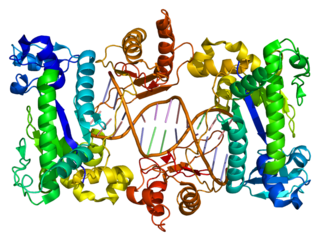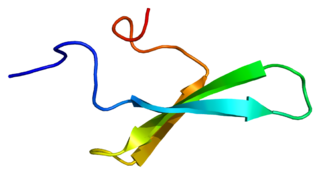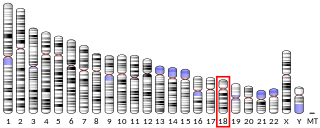DNA polymerase kappa is a DNA polymerase that in humans is encoded by the POLK gene. It is involved in translesion synthesis. [4] [5] [6]
DNA polymerase kappa is a DNA polymerase that in humans is encoded by the POLK gene. It is involved in translesion synthesis. [4] [5] [6]

The TATA-binding protein (TBP) is a general transcription factor that binds specifically to a DNA sequence called the TATA box. This DNA sequence is found about 30 base pairs upstream of the transcription start site in some eukaryotic gene promoters.

Thomas Bill Kornberg is an American biochemist who was the first person to purify and characterise DNA polymerase II and DNA polymerase III. He is currently a professor of biochemistry and biophysics at the University of California, San Francisco, and is working on Drosophila melanogaster development.

DNA-directed RNA polymerase II subunit RPB2 is an enzyme that in humans is encoded by the POLR2B gene.

DNA-directed RNA polymerase II subunit RPB9 is an enzyme that in humans is encoded by the POLR2I gene.

DNA polymerase iota is an enzyme that in humans is encoded by the POLI gene. It is found in higher eukaryotes, and is believed to have arisen from a gene duplication from Pol η. Pol ι, is a Y family polymerase that is involved in translesion synthesis. It can bypass 6-4 pyrimidine adducts and abasic sites and has a high frequency of wrong base incorporation. Like many other Y family polymerases Pol ι, has low processivity, a large DNA binding pocket and doesn't undergo conformational changes when DNA binds. These attributes are what allow Pol ι to carry out its task as a translesion polymerase. Pol ι only uses Hoogsteen base pairing, during DNA synthesis, it will add adenine opposite to thymine in the syn conformation and can add both cytosine and thymine in the anti conformation across guanine, which it flips to the syn conformation.

Mitogen-activated protein kinase kinase kinase 14 also known as NF-kappa-B-inducing kinase (NIK) is an enzyme that in humans is encoded by the MAP3K14 gene.

Transcription elongation regulator 1, also known as TCERG1, is a protein which in humans is encoded by the TCERG1 gene.

DNA repair protein REV1 is a protein that in humans is encoded by the REV1 gene.

DNA excision repair protein ERCC-8 is a protein that in humans is encoded by the ERCC8 gene.

DNA polymerase delta subunit 2 is an enzyme that in humans is encoded by the POLD2 gene. It is a component of the DNA polymerase delta complex.

Helicase-like transcription factor is an enzyme that in humans is encoded by the HLTF gene.

Poly(A) polymerase alpha is an enzyme that in humans is encoded by the PAPOLA gene.

Nuclear factor of kappa light polypeptide gene enhancer in B-cells inhibitor, epsilon, also known as NFKBIE, is a protein which in humans is encoded by the NFKBIE gene.

Protein reversionless 3-like (REV3L) also known as DNA polymerase zeta catalytic subunit (POLZ) is an enzyme that in humans is encoded by the REV3L gene.

Myosin-14 is a protein that in humans is encoded by the MYH14 gene.

DNA-directed RNA polymerase I subunit RPA34 is an enzyme that in humans is encoded by the CD3EAP gene.

DNA polymerase eta, is a protein that in humans is encoded by the POLH gene.

Elongator complex protein 2 is a protein that in humans is encoded by the ELP2 gene.

Poly(A) polymerase gamma is an enzyme that in humans is encoded by the PAPOLG gene.
DNA polymerase IV is a prokaryotic polymerase that is involved in mutagenesis and is encoded by the dinB gene. It exhibits no 3′→5′ exonuclease (proofreading) activity and hence is error prone. In E. coli, DNA polymerase IV is involved in non-targeted mutagenesis. Pol IV is a Family Y polymerase expressed by the dinB gene that is switched on via SOS induction caused by stalled polymerases at the replication fork. During SOS induction, Pol IV production is increased tenfold and one of the functions during this time is to interfere with Pol III holoenzyme processivity. This creates a checkpoint, stops replication, and allows time to repair DNA lesions via the appropriate repair pathway. Another function of Pol IV is to perform translesion synthesis at the stalled replication fork like, for example, bypassing N2-deoxyguanine adducts at a faster rate than transversing undamaged DNA. Cells lacking dinB gene have a higher rate of mutagenesis caused by DNA damaging agents.